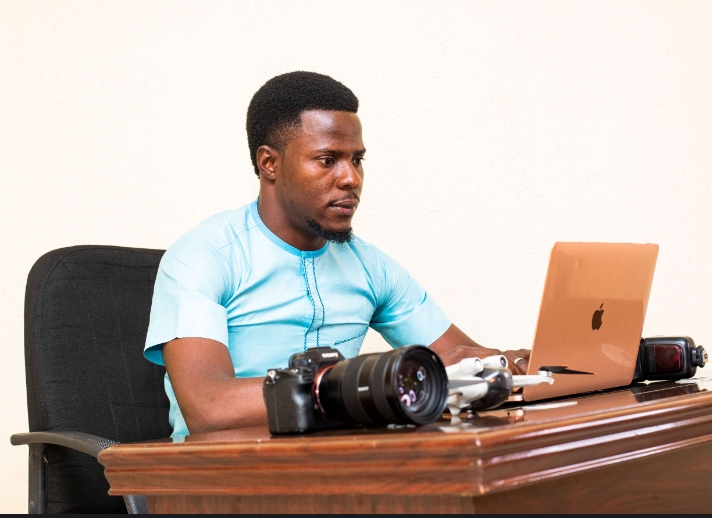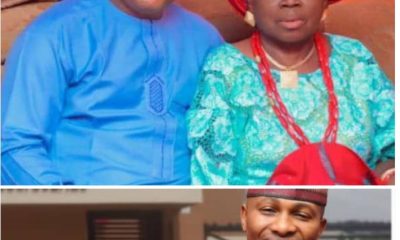Interview
I Started Practicing Photojournalism Using My Android phone At NYSC Camp – Nigerian Photojournalist

By Adeleke Maria
Citybuzznews in an exclusive interview with Mr Joshua Ojo,an official photographer to the Oyo State Ministry of Public Works and Transport who has been practicing photojournalism in the past 6 years
Can we meet you?
My name is Joshua Ojo. I’m the first of five children, a Nigerian Photographer, and a photojournalist. I currently serve as the official photographer for the Oyo State Ministry of Public Works and Transport.
Where are you from?
I’m from Ogbomoso, Oyo state, Oriire Local government to be precise.
What did you study in school?
I studied Urban and Regional Planning at Ladoke Akintola University of Technology
(LAUTECH), Ogbomoso.
When did you start photojournalism?
I started my career in photojournalism professionally in the year 2019.
When I finished secondary school in the year 2010, my Dad enrolled me immediately in the
pre- degree program of Ladoke Akintola University of Technology (LAUTECH), Ogbomoso.
Though, I actually put in for Mechanical-Engineering because I fell in love with some of the topics we did in physics and chemistry, but by the time my admission was out, I was given Urban and Regional planning.
I really wanted to forfeit the admission then, but people kept reminding me about how difficult it can actually be to gain a University admission and
more-so, as at the time, Lautech had to increase their school fees from forty thousand naira to around a hundred thousand naira. So, I also nursed the fear that if I didn’t study then ,I might have to pay more for school fees as I believe it will keep increasing.
At that time, I didn’t really have a mind of my own, because I didn’t want to waste the efforts of my parents in getting me schooled, so I studied what was given to me because I believed it was the best choice for me.
After my graduation from LAUTECH, I got mobilised by NYSC to Potiskum camp in Yobe State, that was in the year 2018. At the camp, we were advised to be serious with the development of a particular skill we were very passionate about, a skill we can build upon
after the compulsory three weeks of regimental in-camp activities. This was, according to the then State NYSC Coordinator – Madam Grace Adzar, because there is no sustainable supply
of white-collar jobs to accommodate the ever-increasing number of graduates in Nigeria.
I went for the Skill Acquisition and Entrepreneurship Development (SAED) lectures, and I put in for Photography which I had been practising with my phone earlier. That was where
my photography journey started. When I returned from Camp too, I enrolled for the postgraduate programme of the International Institute of Journalism (IIJ), Abuja at their study centre here in Ibadan, Iyaganku Area to deepen my knowledge of story-telling with my lens.
Why did you choose this path?
I’ve always had a passion for creativity. As a child, I was drawn to the pictures in
newspapers, and I realised that I could better understand stories through images. Photography allows me to tell stories visually, which has always fascinated me.
Who were your mentors in photography before you started?
In Nigeria, I looked up to and followed photographers like Taibat Ajiboye, Bayo
Omoboriowo, Tolani Ali, Ayo Adeagbo, and Samuel Ojo, among others.
Can you describe your experience in Photojournalism and your most notable projects or assignments?
My experience in photojournalism has been rewarding and full of growth. Some of my most notable projects include capturing images of road constructions, road terminals, and bridges,
which have been well-received for their quality and impact.
How did you get to work with the Oyo State Ministry of Public Works and Transport?
When I was done with my three weeks camping at the NYSC Orientation Camp in Potiskum,Yobe State, my Uncle, RT Hon Joshua Olagunju Ojo, who was the Speaker of Oyo State,made a call to the NYSC State Coordinator to make a case for my redeployment to the Oyo
State House of Assembly. Here, I eventually served at the Office of the then Director,Planning Research and Statistics who later got promoted as the Deputy Clerk of the House, Madam Yetunde Awe Oludara (now retired as a Clerk) as a graphic designer and a computer operator, which added to my growing knowledge in photography.
By the time I was done with my one-year compulsory service, my uncle was done serving as the Speaker of Oyo
State.
At that point, I didn’t just want to go back to sit down with my parents and go about in search of a job. I was really disturbed by these thoughts that he gave me headache and sleepless
nights for days. So, I approached Madam Yetunde Awe, and she really calmed me down and asked what I wanted and how I wanted to go about it. I explained all to her, and since I’d started my journey in learning more about photojournalism, she referred me to the Oyo State Ministry of Public Works and Transport and that was how I became their official
photographer.
Is photojournalism a lucrative one?
Yes, it is lucrative, especially for those who know their craft. While there are ups and downs,the rewards are worth the efforts.
What equipment do you typically use for photojournalism?
I use a Nikon Full Frame Camera D750 and a DJI Mini 2 Pro Drone. These are my personal
gadgets.
Can you describe an example of a challenging situation you faced while on an assignment and how you handled it
One challenging situation was when some “area boys”at Sango, Ibadan, snatched my camera and demanded money to return it. I had to give them some of my transport money to get it
back. This experience has taught me to assess the environment before taking out my camera.
Can you describe your process for selecting and editing photographs for publication?
I choose the most captivating and creative pictures that tell a story at a glance. I often set my camera to take multiple shots per second and then select the best ones during editing.
How do you handle criticism or feedback on your work?
As much as I get positive feedback almost all the time, I also get negative feedback. I only make sure I don’t take any of those feedbacks to heart so that they don’t affect me. For any negative feedback, I try to work on myself to make my shots better.
However, there are times when the pictures are not bad, you’ll see people making degrading comments for reasons best known to them.
So, either negative or positive feedback, one should not relent and one should not allow it get into one’s head.
How do you approach working in challenging or dangerous environments such as conflict zones or disaster areas?
I try to make sure I study the environment well because we all know of journalists whose cameras have been destroyed,they themselves beaten up,seizing of their gadgets and all while
doing their job.
For instance, I was opportune to come to the scene at Iwo road during a clash that happened between cult members.
When I got there, I realized the environment was still tensed, and the “area boys” were all out.So I had to study them and the environment well, too, before I could bring out my camera to
take shots because, in all, my safety is paramount.
Do you use Social Media platforms to promote your work/engage your audiences?
Yes, I do. I share my work on the Oyo State Ministry of Public Works and Transport’s platforms and my personal account, @joshuaOjoReal.
What’s your word of advice to aspiring photojournalists?
Focus on professionalism as you grow. The journey may be challenging, but the rewards will be worth it, just like the legendary Alfred Eisenstaedt, who is considered the father of photojournalism.
Continue Reading







